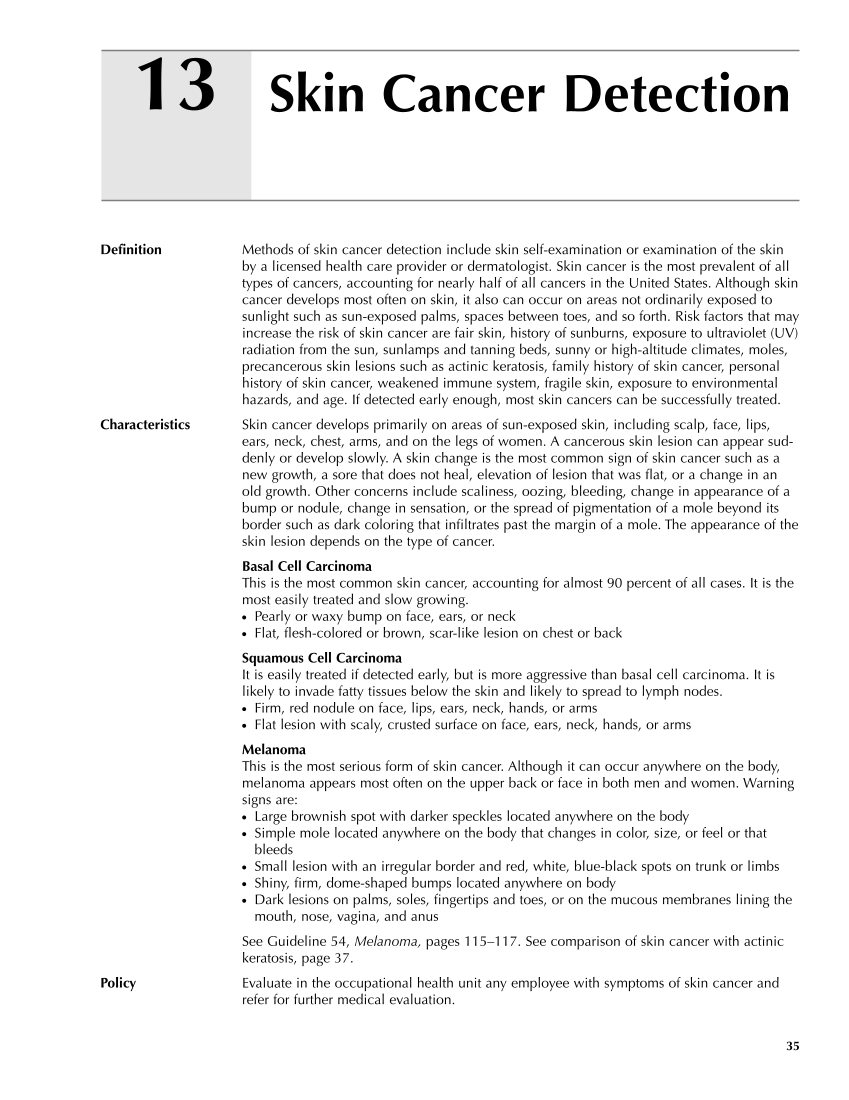35 Skin Cancer Detection 13 Definition Methods of skin cancer detection include skin self-examination or examination of the skin by a licensed health care provider or dermatologist. Skin cancer is the most prevalent of all types of cancers, accounting for nearly half of all cancers in the United States. Although skin cancer develops most often on skin, it also can occur on areas not ordinarily exposed to sunlight such as sun-exposed palms, spaces between toes, and so forth. Risk factors that may increase the risk of skin cancer are fair skin, history of sunburns, exposure to ultraviolet (UV) radiation from the sun, sunlamps and tanning beds, sunny or high-altitude climates, moles, precancerous skin lesions such as actinic keratosis, family history of skin cancer, personal history of skin cancer, weakened immune system, fragile skin, exposure to environmental hazards, and age. If detected early enough, most skin cancers can be successfully treated. Characteristics Skin cancer develops primarily on areas of sun-exposed skin, including scalp, face, lips, ears, neck, chest, arms, and on the legs of women. A cancerous skin lesion can appear sud- denly or develop slowly. A skin change is the most common sign of skin cancer such as a new growth, a sore that does not heal, elevation of lesion that was flat, or a change in an old growth. Other concerns include scaliness, oozing, bleeding, change in appearance of a bump or nodule, change in sensation, or the spread of pigmentation of a mole beyond its border such as dark coloring that infiltrates past the margin of a mole. The appearance of the skin lesion depends on the type of cancer. Basal Cell Carcinoma This is the most common skin cancer, accounting for almost 90 percent of all cases. It is the most easily treated and slow growing. ● Pearly or waxy bump on face, ears, or neck ● Flat, flesh-colored or brown, scar-like lesion on chest or back Squamous Cell Carcinoma It is easily treated if detected early, but is more aggressive than basal cell carcinoma. It is likely to invade fatty tissues below the skin and likely to spread to lymph nodes. ● Firm, red nodule on face, lips, ears, neck, hands, or arms ● Flat lesion with scaly, crusted surface on face, ears, neck, hands, or arms Melanoma This is the most serious form of skin cancer. Although it can occur anywhere on the body, melanoma appears most often on the upper back or face in both men and women. Warning signs are: ● Large brownish spot with darker speckles located anywhere on the body ● Simple mole located anywhere on the body that changes in color, size, or feel or that bleeds ● Small lesion with an irregular border and red, white, blue-black spots on trunk or limbs ● Shiny, firm, dome-shaped bumps located anywhere on body ● Dark lesions on palms, soles, fingertips and toes, or on the mucous membranes lining the mouth, nose, vagina, and anus See Guideline 54, Melanoma, pages 115–117. See comparison of skin cancer with actinic keratosis, page 37. Policy Evaluate in the occupational health unit any employee with symptoms of skin cancer and refer for further medical evaluation.
Purchased from OEM Press by (ge corporate access). (C) 2013 OEM Health Information, Inc. All rights reserved.












































































































































































































































































































































































































































